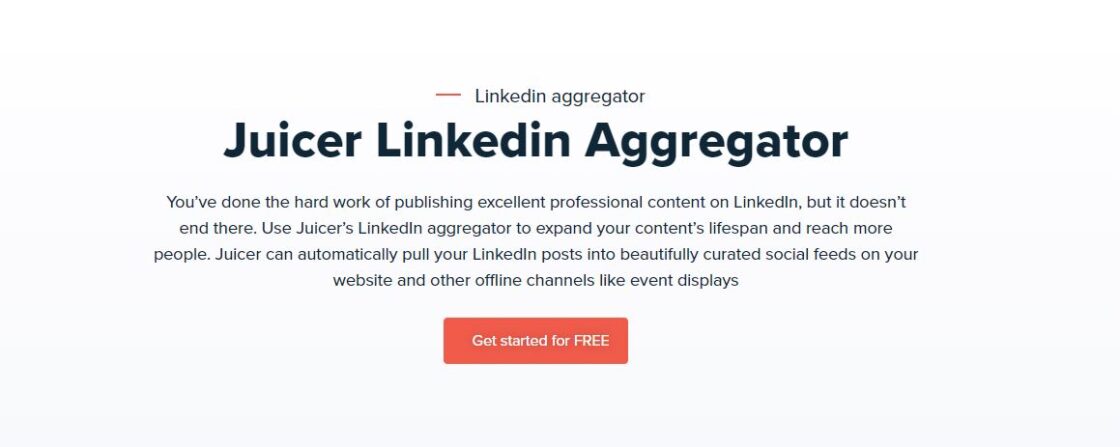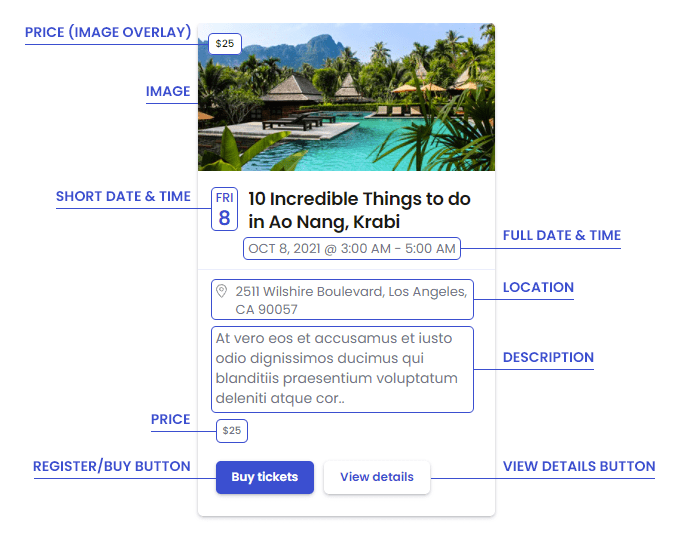If you’re searching for the ideal LinkedIn aggregator to curate content from your LinkedIn profiles and showcase it on your website, you’ve probably heard of Juicer.io and Curator.io.
Though Juicer and Curator have a lot of similar features, there is a significant difference between the experience you get on both platforms and the price you’ll pay for their aggregation tools.
This complete comparison guide will help you make the right choice for your business.
Juicer vs Curator: The Quick Overview
Here’s a quick look at how these two solutions stack up side by side.
| Juicer | Curator | |
| Top Features | Add public and personal LinkedIn posts to your feed Curate and control what your audience sees with advanced feed moderation features Track content engagement and performance in Juicer’s advanced analytics dashboard |
Add posts from public LinkedIn profiles to your social media feed. 20+ customizable feed templates API Access |
| Ease of Use | ✅ | ✅ |
| Pricing | Free plan; paid plans start at $19 per month | Free plan; paid plans start at $25 per month |
| Customer Support | Excellent | Poor |
Juicer vs Curator: The Core Features
As mentioned above, Juicer and Curator share many similarities. They’re both flexible social media aggregators with convenient LinkedIn embedding tools. However, they have core differences in terms of their features and capabilities.
1. Social Media Platform Support
First, let’s look at the social media platforms you can access with both tools. Although you might just be looking for a LinkedIn embed tool now, you may want to create more comprehensive social feeds in the future with connectors for other profiles and platforms.
Juicer is one of the most flexible social media aggregators, integrating with numerous platforms. Alongside LinkedIn, you can pull and display content from Twitter (X), Facebook, Instagram, TikTok, and more.
Curator also offers a range of connection options, but there aren’t nearly as many platforms. You get about half as many of the connection options available on Juicer, and the channels you can access will vary depending on your pricing plan.
2. Social Media Wall Moderation and Customization
Content moderation and customization options are crucial when choosing an effective LinkedIn aggregator. Moderation tools will help you to preserve your brand’s reputation, ensuring you only showcase the positive content. On the other hand, customization tools allow you to adapt your social media feed to match your brand image.
Juicer offers exceptional moderation tools, giving you 100% control over the content you share. You can automatically exclude posts with certain words from your feed. You can also set up moderation queues with custom rules and access instant notifications for posts awaiting approval.
Juicer has nine social media feed customization themes that you can apply to your feed in a few clicks. You can also use custom CSS to add your brand logo and color schemes.
Curator’s moderation and customization tools are similar but not quite as advanced. As with Juicer, you can automatically set rules for your moderation workflow and implement filtering options. You can also edit content to suit your specific needs. Additionally, Curator gives you ways to showcase your brand through different feed styles and themes.
Related:
A complete guide on how to embed LinkedIn feed on a website
Juicer vs Curator: Ease of Use
Overall, the user experience is very similar for both LinkedIn embedding tools, so you shouldn’t have any problems regardless of which option you pick.
Juicer.io User Experience

Getting started with Juicer is extremely simple. You can sign up for free and build a unique social feed in seconds. The free version of the plan even automatically updates your feed every 24 hours. On paid plans, you can tap into advanced customization options, new templates, widget integrations, and even CSS code options if you have developer knowledge.
When you’re ready to embed your LinkedIn feed into your website, you only need to copy and paste a snippet of code. There’s even the option to customize your embed experience, adding clickable post links and other unique capabilities.
Curator.io User Experience
Curator.io is relatively easy to set up. You can also access a free plan to get started, which includes support for social content from up to three sources. A simple onboarding checklist guides you through setting up your social feed, and the moderation and filtering tools are easy to use.
On paid plans, you can edit posts and add other users to your account to collaborate on your campaigns. Once you’re ready to embed, you can simply copy and paste the available code, just like with Juicer.
Juicer vs Curator: Pricing
Juicer.io offers more flexible pricing than Curator. Let’s dig into this a bit more.
Juicer.io Pricing Plans
With Juicer’s free plan, you get one feed, two sources, unlimited widget integrations, and updates every 24 hours. It also supports analytics and clickable post links on its free plan.
Juicer has three paid plans, with a 10% discount on annual payments:
- Medium ($19 per month): All the features of the free plan, plus five sources, hourly refreshing, no juicer branding, additional platform connectors, support for up to 20,000 views, moderation features, and custom design/CSS options.
- Large ($99 per month): All the features of Medium, plus support for 100,000 views and ten sources, editing, profanity filters, advanced analytics, and extended support. Plus, feeds refresh every 10 minutes.
- Enterprise ($199 per month): All the features of Large, plus unlimited feeds, sources, and feed views. Refreshes happen every minute, and you also get API access, unlimited collaborators, white labeling, user management tools, and priority support.
Curator.io Pricing Plans
With Curator, you get one feed with three sources and unlimited admin users, but widget integrations aren’t limitless. Curator has three standard paid plans and two custom-priced plans for enterprises and white-label companies. You’ll need to contact the Curator team for more information on these packages.
- Professional ($25 per month): All the features of the free plan, plus support for five sources, hourly updates, 15,000 views per month, unlimited admin users, no Curator.io branding, and content editing options
- Business ($59 per month): All the features on the Professional plan, plus 15 sources, 15-minute refreshes, unlimited views, API access, and 1 LinkedIn page
- Event ($200 per month): The features of Business, plus support for ten sources, 5-minute updates, and support specific to event promoter needs.
Ultimately, Juicer is more affordable than Curator and offers faster refresh rates and support for more views on its lower-level plans.
Juicer vs. Curator: Customer Support and Service
Juicer and Curator offer 24/7 support on all plans. However, Curator offers companies higher-level priority support on more expensive plans. Plus, enterprise customers can access dedicated on-demand onboarding sessions from the Juicer team.
Notably, both companies have excellent self-help resources, such as FAQ pages, guides, blogs, and videos available online for beginners. As far as we can tell, Curator focuses mainly on email-based support, while you can contact Juicer via email or social media or use the “help” button on the company’s website to access chatbot assistance.
The Verdict: Juicer or Curator?
Juicer and Curator are excellent LinkedIn aggregator tools with easy-to-use interfaces, good value pricing packages, and exceptional features. However, we still think Juicer has an edge. The Juicer solution integrates with more platforms and tools, giving you more flexibility.
Plus, with Juicer, you get more advanced tools for dynamic social feeds that update quickly to showcase all of your latest content immediately. It has affordable pricing plans, and the free plan is generous, too.
Check out Juicer’s pricing options, or sign up for a free account here.
Juicer.io vs. Curator.io FAQs
Find answers to common questions about Juicer and Curator’s LinkedIn aggregator tools.
1. What Does a Social Media Aggregator Tool Do?
Social media aggregator tools collect content from multiple social platforms so you can organize, modify, and share it on your website and other environments. They simplify the process of creating compelling social media feeds.
2. What is Juicer.io?
Juicer.io is a social media aggregator solution that makes it easy to aggregate all of your social media posts and hashtags into a single feed. It connects with a wide range of platforms and offers excellent moderation and customization options.
3. What is the Best LinkedIn Aggregator for Businesses?
Juicer.io is the best LinkedIn aggregator for businesses. It offers flexible pricing plans for companies of all sizes and a free plan with correct aggregator capabilities for smaller brands and creators.
4. What is a LinkedIn Aggregator?
A LinkedIn aggregator is a tool that makes it easy to collect, organize, and embed LinkedIn posts into your website. With your LinkedIn aggregator, you can easily collect all the best content shared on your LinkedIn profiles and manage, filter, organize, moderate, and share that content from a single dashboard.





